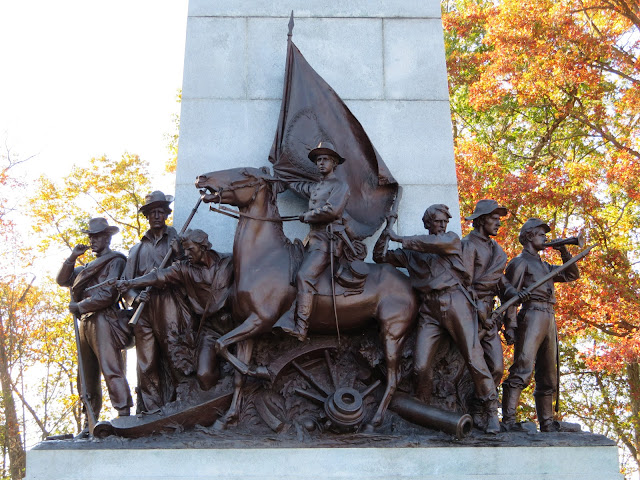After leaving Philadelphia, we continued our history lesson in Gettysburg, site of one of the most famous battles of the Civil War.
Fought from July 1 to July 3, 1863, it was the bloodiest battle of the war, with around 85,000 Union soldiers and 75,000 Confederate soldiers taking part and over 46,000 casualties. The town of Gettysburg was the site of this battle because of the 10 roads that led into town, making it accessible from many directions. Any student of American history knows that President Abraham Lincoln delivered his most famous speech on the site of the battlefield on November 13 of that same year.
 |
| She's a big fan! |
 |
| Just a couple of guys who look better with beards. |
Our first stop the next morning was the Gettysburg National Military Park Museum and Visitor Center. Inside, we viewed the film "A New Birth of Freedom", narrated by Morgan Freeman, and the Gettysburg Cyclorama, a 360 degree painting of the battlefield by French artist Paul Philippoteaus, with narration, lighting and sound effects. The images are very lifelike and the total effect is unique.
We then toured the museum, a well curated collection of items left on the battlefield as well as short movies about each day of the battle, with pictures and correspondence from the participants. It took a couple of hours to get through, but was well worth the time.
Next were the battlefields themselves and the Gettysburg Soldiers' National Cemetery. Here are the remains of 3,555 Union soldiers who died on the battlefields. There are stones organized by State, as well as some markers for unknown soldiers.
Based on records from 1865, these markers represent the following casualties:
- Unknown -- 143 soldiers
- Illinois -- 6 soldiers
- West Virginia -- 11 soldiers
- Delaware -- 15 soldiers
- Rhode Island -- 12 soldiers
- New Hampshire -- 49 soldiers
- Vermont -- 61 soldiers
- New Jersey -- 78 soldiers
- Wisconsin -- 73 soldiers
- Connecticut -- 22 soldiers
- Minnesota -- 52 soldiers
- Maryland -- 22 soldiers
- US Regulars -- 138 soldiers
- Unknown -- 411 soldiers
- Maine -- 104 soldiers
- Michigan -- 171 soldiers
- New York -- 866 soldiers
- Pennsylvania -- 526 soldiers
- Massachusetts -- 159 soldiers
- Ohio -- 131 soldiers
- Indiana -- 80 soldiers
- Unknown -- 425 soldiers
For the Confederate soldiers who died, their bodies lay in scattered field burials and hospital sites until ladies' memorial societies raised funds to have their bodies relocated to their native states starting in the 1870's.
Also inside the cemetery is a monument on the location where Lincoln gave the Gettysburg Address.
Here is a photo taken by acclaimed Civil War Photographer Mathew Brady showing Lincoln delivering the speech.
All throughout the battlefields, which cover miles of terrain, are memorials to the various state military units who fought at Gettysburg, including units from the Confederacy. Many of these memorials list a chronology of the units' involvement in the battle and how many soldiers fought, died, were wounded or just missing.
 |
| Just one of hundreds of similar memorials |
In addition, there are statues commemorating some of the generals who led their troops here and the men they led. See the description of who they represent below.
 |
| Confederate hero or traitor to the Union? |
One of the most impressive monuments was erected by the State of Pennsylvania, listing the names of key generals and every Pennsylvanian who fought in the war.
Like our previous visit to the site of Little Big Horn, this was a sobering experience. Some say that the Civil War ended in 1865, but others maintain that, in some respects, it still going on.














Admiring the commitment you put into your blog and
ReplyDeletedetailed information you provide. It's nice to come across a blog every
once in a while that isn't the same old rehashed material.
Excellent read! I've bookmarked your site and I'm including
your RSS feeds to my Google account.